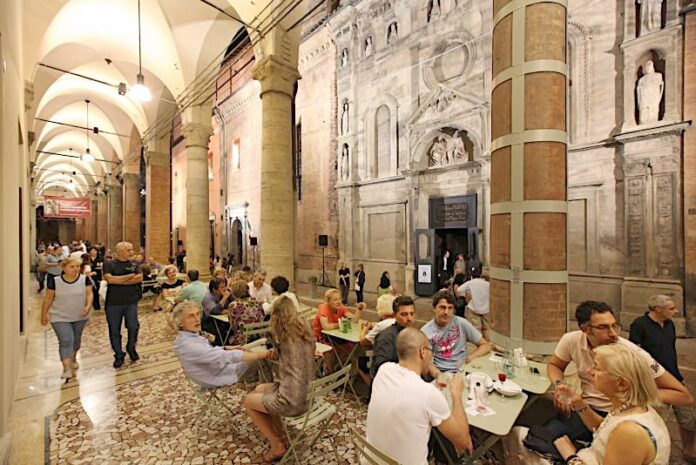
Join the Bolognese for “aperitivo” — a very Italian way to enjoy the life of this city
It’s 6 P.M. on Via Zamboni, and this main artery through Bologna’s university district is just starting to fill with people leaving work. They are headed to one of the many cafes lining the avenue, as they look forward to enjoying one of Bologna’s classic traditions: aperitivo.
People from all walks of life participate in this northern Italian social ritual, said Stefano Magagnoli, a professor at the University of Parma.
Similar to the U.S. happy hour, aperitivo runs loosely from 6 to 9 p.m., and is a way for people to unwind after work. Every aperitivo features a drink – and in Bologna, a university town where cheap meals are popular, it’s also traditional to offer an ample buffet.
From the fancier, more expensive aperitivos, to the casual, less pricey ones, there are options for everyone. Costs range from €3.50 ($4) to €12 (US $14). All include one drink and, at most cafes, unlimited trips to the buffet.
The aperitivo tradition, according to Magagnoli, began in Turin around the end of the 18th century. It started with noblemen and bourgeois who wanted to enjoy their leisure time, and from there, became a new habit of the middle classes. But it wasn’t until after World War II that aperitivo would be a common tradition for people of all classes and backgrounds.
At the beginning of the aperitivo tradition, it was common for people to drink Aperol, an aperitif made of two types of flowers, gentian and cinchona, along with rhubarb. But over the years, wine grew to be the more popular choice, as the quality of wine improved. Magagnoli admits that in the beginning, only men drank the wine, while women were absent from public drinking establishments. This too has changed, with both women and men participating in aperitivo now.
Aperol spritz, a wine-based cocktail that is a combination of wine, flavored syrups and seltzer water, has hands-down become the most popular drink to order at aperitivo time, according to Francesco, a bartender at Caffè Zanarini. Opened in 1930 as a pastry bar, Caffè Zanarini, in the Piazza Galvani, is one of the oldest cafes to in the city to serve aperitivo. Saturdays are the most popular day, but weekdays still draw a crowd. While Francesco may have deemed the spritz the most popular drink, he did so with apprehension, adding that this was the simplest drink at the café. He noted that the bar also serves a variety of elaborate cocktails.

The Aperol spritz is also the most popular drink at Caffé Zamboni, another well-known aperitivo gathering spot. What makes this place unique is the wide variety of food served. From salad to pasta to sushi to slushies, Caffé Zamboni offers something to please every taste.
According to Roberta, a Caffé Zamboni waitress, aperitivo at Caffé Zamboni is considered a pricier option than other aperitivos, but for good reason. At €10 ( $11.66), this cafe offers unique food items not normally offered at other aperitivos, such as sushi, slushies, and a variety of desserts. Despite its location in the university district, and long hours open, tourists are Zamboni’s top patrons, the waitress said – while students gravitate to even cheaper options.
Famous for its university, the oldest in the Western hemisphere, Bologna draws thousands of students from Italy and abroad; aperitivo allows them to enjoy a wide variety of food and drink inexpensively. While aperitivo was once only a thing to do between the end of the workday and dinner, it now often replaces dinner, and is playfully referred to as “apercena” or “appetizer-dinner.”
Bar ‘Senza Nome’ is an unusual option. The cafe blends into the one directly next to it, making it easy to miss. Run and operated by a deaf and mute staff, the cafe is decorated with colorful posters that display sign language symbols. A drink is ordered by pulling a piece of paper off the wall displaying the name of the drink, and a cartoon-like picture of it.

Aperitivo here costs just €1 ($1.17) per plate, plus the cost of a drink. Drinks range in price from €2.50 ($2.90) to €8 ($9.30), making Senza Nome one of the least expensive aperitivo spreads in the city. Of course, this is only if you are able to stop yourself after just one or two plates of the cafe’s delicious couscous, potatoes, salad and sautéed broccoli.
In contrast to the more formal Italian dining culture, aperitivo is a laid-back experience, said University of Bologna student Anna Compagnoni.
“It’s a time of the day where you can unwind, eat some light snacks, and talk,” she said. “This is perfect because Italians love to talk!”
Compagnoni added that these days aperitivo is also used to celebrate life accomplishments, birthdays and other milestones.
There’s no doubt that aperitivo has been ingrained into the fabric of Italian life. So, if you’re looking for a way to go native in Bologna, aperitivo is a great place to start.
Where to Enjoy Aperitivo
Caffe Zanarini, Piazza Galvani 1, Bologna. (39)051-275-0041. Aperitivo hours: 6-9 p.m.
Caffe Zamboni, Via Zamboni 6, Bologna. (39) 051-273-102. Aperitivo hours: 6-11 p.m.
Bar Senza Nome, Via Belvedere 11/B, Bologna. (39) 347-044-7422. Aperitivo hours: 7:30-9 p.m.

